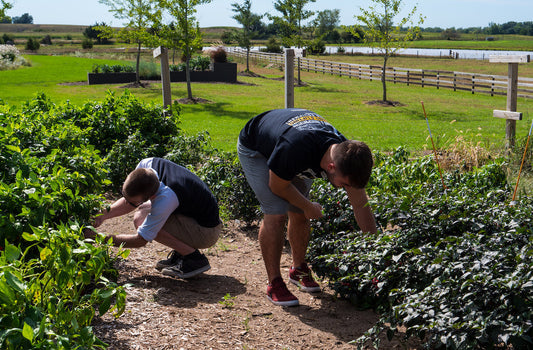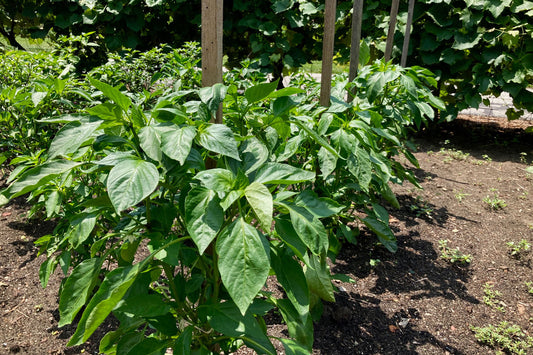Growing hot peppers is one of the most satisfying and rewarding things to do, and you can receive many benefits from growing them in your garden. But before you get your hands dirty, it’s important that you know what nutrients your plants need in order to thrive for months to come. There are a couple of tips you can easily do to ensure your plants get the nourishment they need.
Two things to know: check the pH levels of your soil and use the right fertilizer.
Soil pH, or the soil reaction, is an indication of the acidity or alkalinity of soil and is measured in pH units. The pH scale can go from 0 to 14 with pH 7 as the neutral point. For the soil pepper plants need, we need pH levels between 6 to 7.
It can be discouraging not knowing what fertilizer you should use due to the amount of fertilizers being sold everywhere. Questions you might ask yourself are if you’re fertilizing too often, not too much, or using the right fertilizer. In this blog, we’ll go through what type of nutrients do plants need and what fertilizers you should be using for maximum growth. Watch our video below on what fertilizer to use and how much you should use:
Three Key Nutrients for Strong, Happy Pepper Plants

The three key nutrients you need for your pepper plants are nitrogen, phosphate, and potassium.
Nitrogen is the most important element as it supports the regulation of photosynthesis, which then encourages foliage production and leafy growth. Pepper plants would look a little strange without leaves, so nitrogen will help them develop healthy leaves and pepper pods.
Phosphate provides phosphorous, which enables plants to consume solar energy. This second key nutrient allows the pepper plant to absorb energy from the sun which is what it needs to develop strong roots and robust peppers.
The last key nutrient is Potassium, which plays a critical role in water and nutrient movement, allowing photosynthesis to happen smoothly. In other words, the elements keep water and other nutrients flowing through a plant.
These macronutrients are sometimes known as the big three in the pepper world because of their crucial role in creating a healthy plant. The nutrients can also be abbreviated as N.P.K., so memorizing these elements can come in handy when you’re researching fertilizers!
Additional Nutrients Pepper Plants Need
Secondary Nutrients
In addition to the three key nutrients we explained above, there is a collection of additional nutrients your pepper plants will need. Pepper plants are partial to three secondary nutrients which are Calcium, Magnesium, and Sulfur, which the plants will need in smaller quantities.
Calcium helps other nutrients get into the plant and creates enzymic reactions. The calcium pectinate helps bond the plant’s cell walls together, and the cells in leaves and peppers. If the plant lacks calcium, or if the pepper pods grow too quickly for the plant to supply enough calcium, the bottoms of the pods can begin to rot due to the breakdown of their cell walls.
Fun Fact: Calcium is the same substance that goes into making jams and jellies!
Magnesium is responsible for the creation of chlorophyll, the green pigment that’s crucial in photosynthesis. It also helps create ATP and calcium pectinate, which glues the cell walls together. With Magnesium, this will allow plants to better take in valuable nutrients (like nitrogen and phosphorus) and greatly improves a plant’s ability to produce flowers and peppers.
Sulfur, the last secondary nutrient, is best known for its ability to control insects and fungal diseases, but it’s also necessary to produce amino acids, vitamins, and enzymes.
Trace nutrients
Pepper plants benefit more than these six nutrients, just as people benefit from eating more than six types of food. The other twelve nutrients that are supplied by soil and strengthened by fertilizer are:
- Boron – necessary for flowering and cell formation
- Copper – important in photosynthesis and reaction of enzymes
- Iron – goes into cytochromes, which are necessary for plant transpiration. This also helps the plant make chlorophyll
- Manganese – this mineral form chlorophyll and enzymes, and creates chloroplasts which are the tiny bodies found only in the plant cell that makes food and contain the molecules of chlorophyll. Manganese is important in plant respiration.
- Molybdenum – the mineral goes into creating enzymes and amino acids
- Zinc – this activates enzymes and allows the reading of the plant’s genetic code.
Healthy soil already contains these nutrients, and if it doesn’t, there are available products that will do the job. Getting the nutrients into the soil for the lawn or garden is part of the task of fertilizing it and keeping it healthy throughout the year!
What Fertilizers Should I Use for My Pepper Plants?
There are many fertilizers out there, but it can be overwhelming knowing which one to use, which is best for your pepper plants, or how often you should use it. Luckily, we have a few fertilizer options that will promote the best plant growth, and tips on the recommended usage for those options!
Option 1: Supre Myco Tea Mix

The Supre Myco Tea is a compost tea alternative with beneficial bacillus mycorrhizae and Trichoderma, and is a great formula for getting healthy mycrobes in your soil for plants to feed on. This contains a proprietary blend of ProBiotic beneficial bacteria, fungi, kelp, and molasses to enhance soil which is a bonus for your plants. We have two available sizes for you to choose, 5 Gallons and 5 Ounces.
We recommend that you use 1 teaspoon per 1 gallon (we used 3 teaspoons of Supre Myco Tea for 3 gallons of water for our garden). Start off by diluting and mixing the powder into water thoroughly until fully dissolved. After the dilution of the powder and water, evenly saturate the root zone of the plant. Start at the crown or basin of the plant and drench the soul 360 degrees, slowly working your way outward until the entire root ball is saturated. This can be tank-mixed or blended into a dry mix and applied with the fertilizer! The Supre Myco Tea mix should be added to gardens every 30 days to prevent overfertilizing, which could cause more harm than good in the long run.
Note that watering into the soil increases the effectiveness.
Option 2: Epsom Salt and Miracle-Gro Mix

This fertilizer mix is Pepper Joe’s favored method for growing strong, healthy plants. You can typically find Miracle-Gro at a store near you like Walmart, or you can purchase the size you want online. You can use any of Miracle-Grow’s Plant Food products or Tomato Plant Food.
To make the mix, grab 1.5 tablespoons of Epsom Salt, 3 Tablespoons of Miracle-Gro, and 3 gallons of water. Mix the Miracle-Gro and Epsom Salt into the water thoroughly to fully dissolve the mix. Spread the water mixture evenly at the base of the plant in a full circle to hit the roots. The Epsom Salt and Miracle-Gro mix should be added to gardens every 30 days to prevent over-fertilizing.
Additional Things to Know about Fertilizing Pepper Plants

You can use both Supre Myco Tea Mix and Epsom Salt and Miracle Gro Mix for their needed nutrients, but you can also use just the Epsom Salt and Miracle-Gro Mix independently once a week with their normal watering schedule. If you wish to use both fertilizer options, we recommend following the schedule:
Week 1: Epsom Salt and Miracle-Gro
Week 2: Normal Water
Week 3: Myco Tea
Week 4: Normal Week
Make sure that you’re watering the peppers at the soil and do not water on top of the plants. The water on the leaves acts as a magnifying glass and can sun-scald (aka sunburn) your plants. It hurts when we get terribly sunburned, so make sure your plants don’t go through the same thing that we do!
If you’d like to up your game when growing hot peppers, we have some of the best and most essential growing and indoor gardening supplies like grow tents, grow lights, and fertilizers and nutrients.
Got questions? Contact us and we'll be able to assist you.
More Grow with Joe Tips for Your Pepper Plants
If you’re new to growing hot peppers, or looking for tips for better plant growth, we can help you have a successful growing experience from seed to harvest. With our easy-to-follow guide, read Grow with Joe tips here so you can get that seed to a beautiful, strong pepper plant with delicious peppers.
- Transplanting Tips
- How to Get Rid of Pests on Pepper Plants
- Pruning Pepper Plants
- Harvesting Peppers
When it comes to pepper seeds, we’ve got you covered with a huge assortment of sweet and bell pepper seeds, rare and exotic pepper seeds, and of course our popular super-hot pepper seeds.
We also have a huge selection of tomato seeds with some pretty unique varieties, plus onion seeds, basil seeds, and cilantro seeds. It’s everything you need for some delicious garden-fresh salsa.
Don’t want to start from seed? Let Joe can do the germination work for you and get live pepper seedlings shipped right to your door. Happy gardening!







